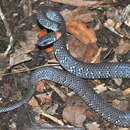en
names in breadcrumbs


The Asian snail-eating snakes, which are specialized feeders on terrestrial snails and slugs, have long been recognized as a distinct lineage since the early nineteenth century, first as a subfamily (Pareatinae) within the Colubridae and more recently as a distinct family, Pareatidae. Most snakes in this group are placed in the genus Pareas. The genus Pareas, which is widely distributed in the Oriental region. Since the description of P, nigriceps in 2009, the revalidation of P chinensis by Guo et al. (2011) , and the description of P. vindumi in 2015, twelve species are included in this genus. Pareas snakes are mainly arboreal and nocturnal. (Vogler 2015 and references therein).
These small snakes are relatively homogeneous in color pattern and scalation and the taxonomy of this group at the species level has been very fluid,Guo et al. (2011) undertook a phylogenetic analysis of the Pareatidae using nuclear and mitochondrial DNA sequence data in an attempt to bring some clarity to this situation. Based on their results, Guo et al. concluded that Pareatidae is composed of four major lineages, including two apparently distinct Pareas lineages. Specifically, theyfound that P. carinatus and P. nuchalis are genetically quite divergent from their congeners (these two species also differ from other Pareas in cephalic scalation and distribution pattern, as detailed and illustrated in Guo et al. 2011). Geographically, P. carinatus and P. nuchalis occur mainly throughout the Indochinese Peninsula and the Sunda Islands, whereas most Pareas species are found in central and southern China and the northern Indochinese Peninsula (although P. margaritophorus and P. hamptoni are found in the southern Indochinese Peninsula). Guo et al. suggest that (P. carinatus + P. nuchalis) and the remaining Pareas species may belong in different genera. In another finding, although P. formosensis and P. chinensis are morphologically very similar, the DNA-based phylogeny indicates that they are not even sister taxa, contradicting assertions that these two names are synonyms or belong to a "fomosensis-chinensis" species complex.
(Guo et al. 2011 and references therein)
Because dextral (clockwise) coiling predominates among terrestrial snails and this has apparently resulted in most pareatid snakes have evolved asymmetry in mandibular tooth number, which probably facilitates feeding on dextral snails and possibly facilitated the diversification of these snakes. Hoso et al. (2007, 2010) have argued that predation by pareatid snakes has played an important role in the evolution and speciation in some snail lineages (Hoso et al. 2007, 2010 and references therein)
Götz (2002) noted thatadaptations for snail extraction have arisen in at least five different colubrid snake groups (Dipsadinae, Pareatinae, Tomodon, Storeria and Duberria), but that only some dipsadines (Dipsas, Sibynomorphus) and the genus Pareas are known as specialists feeding exclusively on slugs and snails, using an extraction method based entirely on mandibular transport (Götz 2002 and references therein). Götz (2002) described the feeding behaviour of captive individuals of the nocturnal and arborealPareas carinatus and compare it with feeding behavior of the Dipsadinae obased on published information. Danaisawad et al. (2015) studied the feeding behavior of P. carinatus and found that snakes of this species, which do not show clear asymmetry in their dentition and striking direction, could prey on dextral and sinistral snails with similar efficiency.